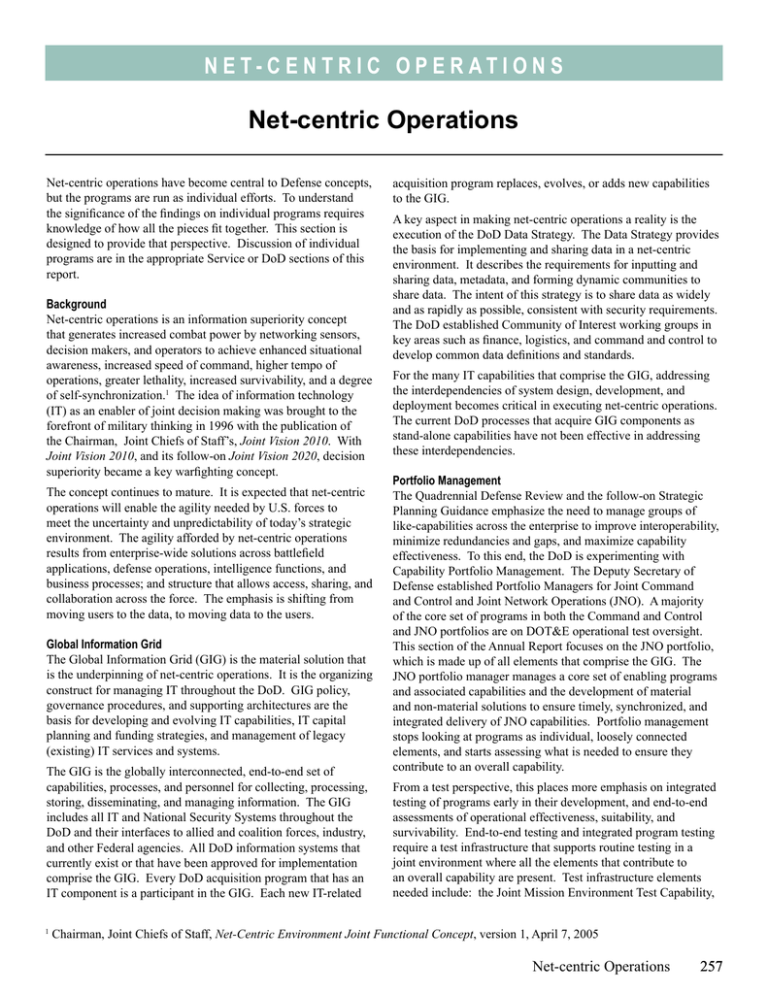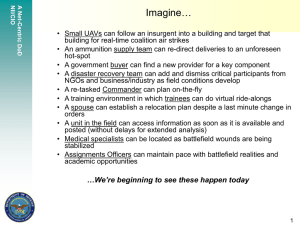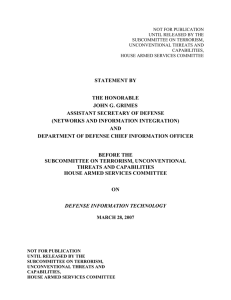Net-centric Operations
advertisement

Ne t - Ce n t r i c Ope r a t i o n s Net-centric Operations Net-centric operations have become central to Defense concepts, but the programs are run as individual efforts. To understand the significance of the findings on individual programs requires knowledge of how all the pieces fit together. This section is designed to provide that perspective. Discussion of individual programs are in the appropriate Service or DoD sections of this report. Background Net-centric operations is an information superiority concept that generates increased combat power by networking sensors, decision makers, and operators to achieve enhanced situational awareness, increased speed of command, higher tempo of operations, greater lethality, increased survivability, and a degree of self-synchronization.1 The idea of information technology (IT) as an enabler of joint decision making was brought to the forefront of military thinking in 1996 with the publication of the Chairman, Joint Chiefs of Staff’s, Joint Vision 2010. With Joint Vision 2010, and its follow-on Joint Vision 2020, decision superiority became a key warfighting concept. The concept continues to mature. It is expected that net-centric operations will enable the agility needed by U.S. forces to meet the uncertainty and unpredictability of today’s strategic environment. The agility afforded by net-centric operations results from enterprise-wide solutions across battlefield applications, defense operations, intelligence functions, and business processes; and structure that allows access, sharing, and collaboration across the force. The emphasis is shifting from moving users to the data, to moving data to the users. Global Information Grid The Global Information Grid (GIG) is the material solution that is the underpinning of net-centric operations. It is the organizing construct for managing IT throughout the DoD. GIG policy, governance procedures, and supporting architectures are the basis for developing and evolving IT capabilities, IT capital planning and funding strategies, and management of legacy (existing) IT services and systems. The GIG is the globally interconnected, end-to-end set of capabilities, processes, and personnel for collecting, processing, storing, disseminating, and managing information. The GIG includes all IT and National Security Systems throughout the DoD and their interfaces to allied and coalition forces, industry, and other Federal agencies. All DoD information systems that currently exist or that have been approved for implementation comprise the GIG. Every DoD acquisition program that has an IT component is a participant in the GIG. Each new IT-related 1 acquisition program replaces, evolves, or adds new capabilities to the GIG. A key aspect in making net-centric operations a reality is the execution of the DoD Data Strategy. The Data Strategy provides the basis for implementing and sharing data in a net-centric environment. It describes the requirements for inputting and sharing data, metadata, and forming dynamic communities to share data. The intent of this strategy is to share data as widely and as rapidly as possible, consistent with security requirements. The DoD established Community of Interest working groups in key areas such as finance, logistics, and command and control to develop common data definitions and standards. For the many IT capabilities that comprise the GIG, addressing the interdependencies of system design, development, and deployment becomes critical in executing net-centric operations. The current DoD processes that acquire GIG components as stand-alone capabilities have not been effective in addressing these interdependencies. Portfolio Management The Quadrennial Defense Review and the follow-on Strategic Planning Guidance emphasize the need to manage groups of like-capabilities across the enterprise to improve interoperability, minimize redundancies and gaps, and maximize capability effectiveness. To this end, the DoD is experimenting with Capability Portfolio Management. The Deputy Secretary of Defense established Portfolio Managers for Joint Command and Control and Joint Network Operations (JNO). A majority of the core set of programs in both the Command and Control and JNO portfolios are on DOT&E operational test oversight. This section of the Annual Report focuses on the JNO portfolio, which is made up of all elements that comprise the GIG. The JNO portfolio manager manages a core set of enabling programs and associated capabilities and the development of material and non-material solutions to ensure timely, synchronized, and integrated delivery of JNO capabilities. Portfolio management stops looking at programs as individual, loosely connected elements, and starts assessing what is needed to ensure they contribute to an overall capability. From a test perspective, this places more emphasis on integrated testing of programs early in their development, and end-to-end assessments of operational effectiveness, suitability, and survivability. End-to-end testing and integrated program testing require a test infrastructure that supports routine testing in a joint environment where all the elements that contribute to an overall capability are present. Test infrastructure elements needed include: the Joint Mission Environment Test Capability, Chairman, Joint Chiefs of Staff, Net-Centric Environment Joint Functional Concept, version 1, April 7, 2005 Net-centric Operations 257 Ne t - Ce n t r i c Ope r a t i o n s improved modeling and simulation, strengthened links between testing and training, and revised methods for identifying and evaluating how one system contributes to the capability provided by a portfolio of systems or to the accomplishment of a mission. Joint Network Operations Portfolio The JNO core programs that are on DOT&E test oversight fall into four basic categories: foundation products, backbone networks, deployed networks, and space-based communications. Although developed separately, these programs are interdependent, in that they each contribute to a Foundation Products The Net-Centric Enterprise Services (NCES) program, transitions DoD to a service-oriented architecture (SOA). The NCES program has three basic areas where it will be developing reusable services for the entire DoD IT infrastructure – collaboration; content discovery and delivery; and SOA services that are designed to support network operations such as security and network management. The SOA serves as the foundation for the integrated GIG enterprise network. SOA is a collection of standards-based interfaces to warfighting and business functions. Applications leverage SOA through open standards and comprise already existing systems and processes. An SOA consists of service and event interfaces to both legacy systems and newer applications. SOA services are software chunks, or components, constructed 258 Net-centric Operations greater capability than they bring individually. The capabilities provided by all these individual JNO/GIG programs, and others not on DOT&E oversight, integrate to provide the enabling infrastructure for net-centric warfare. The many command and control, intelligence and surveillance, and weapons systems outlined in this report will all rely on the integrated capability provided by these programs to realize the concepts of information superiority: enhanced situational awareness, increased speed of command, higher tempo of operations, greater lethality, increased survivability, and self-synchronization. so that they can be easily linked with other software components. The idea is to assemble software code into a “chunk” that can be shared and reused in many different applications. Another foundation for net-centric warfare is ensuring the protection of DoD networks and data. Information assurance is even more critical as we transition to a networked force, where information sharing across multiple networks and between individual platforms increases our risk to organized information operations attacks. The Public Key Infrastructure program provides the security services for the NCES program in the areas of credential issuance, management, validation, operational enabling of electronic/digital representations of identity for digital signature, Ne t - Ce n t r i c Ope r a t i o n s and encryption services. The most visible product of the Public Key Infrastructure program has been the Common Access Card issued to DoD employees. Modernization of the DoD cryptographic capabilities across the GIG is another facet of improving the net-centric information assurance posture. The Key Management Infrastructure program enables the provisioning of cryptographic key products, symmetric and public keys, and security services. The Key Management Infrastructure program will develop a single, automated, network-accessible, electronic-based Key Management and, predominately, electronic cryptographic product delivery infrastructure. Backbone Networks The backbone network of the GIG is the Defense Information System Network (DISN). The DoD primary internets, the Secret Internet Protocol Router Network (SIPRNET), and Unclassified but Sensitive Internet Protocol Router Network (NIPRNET) are part of the DISN. In 2005, the GIG-Bandwidth Expansion (GIG-BE) program completed operational testing and became part of the DISN. GIG-BE connected key sites around the globe with fiber optic network capabilities, essentially providing unlimited bandwidth for the movement of time sensitive intelligence and operations data to our forces. GIG-BE allows the DISN to support the reach and richness of data sharing envisioned by the GIG. The Air Force Combat Information Transport Systems (CITS) program is developing the next-generation Air Force network for more than 100 locations worldwide. The CITS program focuses on modernizing worldwide fixed-base communications infrastructure with high-speed, high-capacity, reliable, digital information transport. CITS uses commercial off-the-shelf hardware and software, providing network management and information assurance capabilities, effectively modernizing voice-switching systems, and sustaining operations through help desk operator training and technical orders. Spectrum management continues to be a pressing issue for the DoD as our global society becomes more dependent on information and communications technologies. The Global Electromagnetic Spectrum Information System program intends to develop a tool to dynamically manage frequency use among emitters. It will reduce communication interference by deconflicting frequency assignments, enhance situational awareness by geographically depicting interference areas, and deliver robust modeling and simulation of electromagnetic spectrum for joint operational mission planning. It will be used to provide the spectrum management capabilities for programs like Joint Tactical Radio System (JTRS) and Warfighter Information Network – Tactical (WIN-T). Multi-national information sharing has become the norm for DoD today. Coalition operations make it imperative that critical information be shared. However, current policies do not support access to SIPRNET by coalition partners. In response to this need, the Combatant Commands developed, and are using, the Combined Enterprise Regional Information Exchange System network to share information between U.S. forces and coalition partners. The multi-national information sharing program will provide services and applications for the future GIG enterprise information environment and facilitate information sharing among DoD components and eligible foreign nations in support of planning and execution of military operations. The Teleport program is designed to move information from the DISN down to the deployed networks and vice versa. Teleport is a telecommunications collection and distribution point. It provides deployed warfighters with multiband, multimedia, and worldwide reach-back capabilities to DISN. The system integrates, manages, and controls a variety of communications interfaces between the DISN terrestrial and tactical satellite communications (SATCOM) assets at a single point of presence. Deployed Networks and Communications Currently, the deployed networks under OSD oversight and DOT&E test oversight include three programs being developed by the Army. These programs support an increased capability to share and move data around the battlefield by improving bandwidth capacity, communications on the move, and reach-back capabilities. Although not on OSD acquisition oversight, the Air Force, Navy, and Marine Corps all have programs and initiatives to improve the capability of their deployed networks to support net-centric operations concepts and support the vision and goals of the GIG. • The Joint Network Node (JNN) is currently provided to deploying Army forces to replace the Mobile Subscriber Equipment communication nodes. It is an integration of commercial off-the-shelf technologies (Ku satellite communications system) and increases bandwidth. The Army views JNN as the bridge between the older Mobile Subscriber Equipment communications link and the WIN-T program that is still under development. Unit commanders use JNN to provide reliable, high-speed information services and information exchanges to the warfighting force, and as their primary means to control battlefield tempo. JNN is intended to provide communications at the quick halt for Army tactical forces, as well as joint and coalition forces, for the exchange of voice, data, and video from theater to battalion levels. • The WIN-T system is to be the Army’s future high-speed and high-capacity backbone communications network or tactical intranet. It is intended to provide reliable, secure, and seamless video, data, imagery, and voice services. WIN-T will support communications from the sustaining base down to the Future Combat Systems Brigade Combat Team. WIN-T has ground, airborne, and space layers. Key components of the ground layer are the JTRS Ground Mobile Radio, a personal communications device, and a secure wireless local area network. The airborne layer consists of unmanned aerial vehicles or tethered air vehicles in the WIN-T airborne communications node, providing beyond line-of-sight communications. The space layer includes commercial and Net-centric Operations 259 Ne t - Ce n t r i c Ope r a t i o n s military satellites such as the Wideband Gapfiller Satellite (WGS) or Advanced Extremely High Frequency (AEHF) satellites to provide reach-back via the GIG. • Army Future Force concepts include bringing integrated voice, video, and data from joint forces to troops on the ground. This vision requires high data rate, wideband SATCOM operating at extremely high frequencies. High Capacity Communications Capability is expected to result in low-cost SATCOM terminals and an efficient, scalable system that is compact and maximizes available power for the transmit distances needed by warfighters – essentially reducing amplifier size and weight and improving affordability for SATCOM on-the-move systems at the High Mobility Multi-purpose Wheeled Vehicle and Future Combat Systems vehicle level. The JTRS program provides the future communications devices that will use WIN-T and other Service networks to enable net-centric operations. JTRS is a software programmable device that can be integrated into ground, air, and sea platforms, as well as fixed sites. JTRS is designed to provide increased interoperability, flexibility, and adaptability to support the many diverse warfighter communications requirements for voice, data, and video. The Enterprise Domain product line provides the waveform and networking gateway, which will be the interface to the GIG, providing a reach-back capability for the warfighting force. The JTRS program is divided into several product lines: Network Enterprise Domain, Ground Mobile Radio, Handheld/Man-pack/Small Form Fit, Airborne/Maritime/Fix, Multi-functional Information Distribution System, and JTRS Enhanced Multi-band Intra Tactical Radios. Space-Based Communications The final piece of the GIG designed to support net-centric operations concepts are the space-based communications programs. As the amount of information flow increases, and the need to reach-back to remote support sites becomes the norm, the bandwidth provided by these programs becomes critical. These programs provide wide- and narrow-band communications capabilities and link with commands, services, agencies, or individual platforms, either directly or through ground terminals. Satellite programs normally have three basic elements: the space-based satellite itself, the mission control segment, and the ground or airborne terminal (user) segment. Wideband satellite programs under development include the AEHF and the WGS programs. • The AEHF system will follow the Military Strategic, Tactical, and Relay (Milstar) program as the protected backbone of DoD’s integrated military satellite communications architecture. The AEHF is expected to increase system throughput capacity by a factor of ten over the existing Milstar satellites. Data rates range from 75 bits per second to approximately 8 Mega-bits per second. Combatant commanders and operational forces worldwide will use the AEHF system to provide secure, responsive, and survivable space-based military communications. AEHF provides connectivity across the spectrum of mission areas, including 260 Net-centric Operations land, air, and naval warfare; special operations; strategic nuclear operations; strategic defense; theater missile defense; and space operations and intelligence. AEHF represents the third generation of Extremely High Frequency (EHF) SATCOM capability for strategic and tactical communications protected from nuclear effects and jamming activities. • WGS is the next generation wideband component in the DoD’s future military SATCOM architecture and provides communications in both the X-band and Ka-band frequencies. WGS combines vital capabilities onto a single satellite for tactical X-band communications, augments the Global Broadcast Service Phase II system, and provides new two-way Ka-band service. WGS should alleviate the spectrum saturation of X-band to provide increased single-user data rate availability and to increase total satellite capacity over current Defense Satellite Communications System III satellites. The DoD’s narrow-band satellite program is the Mobile User Objective System (MUOS). MUOS is the next generation Ultra High Frequency (UHF) Military Satellite Communications (MILSATCOM) system. It supports the worldwide transport of voice, data, simultaneous voice/data, and streaming video (including access to the GIG) to enable dominant maneuver and information superiority. For the last 30 years, UHF MILSATCOM has operated over individual 5-kHz and 25-kHz bandwidth transponders. MUOS departs from this by adapting a commercial third generation Wideband Code Division Multiple Access (WCDMA) cellular phone architecture using satellites in place of cell towers. Use of WCDMA allows MUOS to increase UHF communication capacity and availability to a level far in excess of what is currently achievable using the existing UHF MILSATCOM system. This technology enables a number of mobile communications devices to include handheld terminals, laptops, and personal communications devices such as JTRS. The Transformational Satellite program is the DoD’s future vision for a single space-based communications backbone. The aim of the program is to provide real-time, high bandwidth connections between military assets – ships, planes, drones, units, even individual ground vehicles – anywhere in the world, providing a critical component of network-centric operations. The Transformational Satellite will provide survivable, protected high capacity Internet-like connectivity for Airborne Intelligence, Surveillance, Reconnaissance, Communications On-the-Move services, and protected strategic communications. The system is intended to be interoperable with deployed and infrastructure networks and provide superior network information assurance. The net-centric force has evolved around the concept of the common operational picture. Having this picture depends on time-stamped, position-location information on our forces in the field. The satellites that comprise the Global Positioning System (GPS) have become the standard for DoD in providing this data. The GPS III satellite program objective is to develop and deploy an improved systems architecture for the NAVSTAR GPS to assure reliable and secure delivery of enhanced position, velocity, and timing signals for the evolving needs of GPS civil and military users. GPS III eliminates numerous existing Ne t - Ce n t r i c Ope r a t i o n s shortcomings and vulnerabilities inherent in the current GPS architecture that threaten to severely impact vital civil commerce, transportation, public safety, as well as military operations in the future. To provide the link between the satellite, individual platforms, and networks, are the terminals. There are two key ground-based terminal programs on DOT&E oversight. The Family of Advanced Beyond Line-of-Sight Terminals (FAB-T) advances EHF capabilities to aircraft, and ground and airborne command post terminals. FAB-T provides a multi-mission capable family of terminals that is based on a common design and open system architecture so it can communicate with different satellites. Once operational, FAB-T is intended to provide critical, protected beyond line-of-sight communications for warfighters via the new AEHF system satellites. In subsequent increments, FAB-T is expected to enable interchange with other beyond line-of-sight and national satellite communications systems such as the WGS. The Navy AEHF Multi-band Terminal (NMT) Program is initially developing Q-band SATCOM submarine and shipboard terminals in support of the U.S. Navy’s ForceNet concept. ForceNet is the Navy’s approach to network-centric operations. NMT provides an integrated communications capability that supports EHF/AEHF Low Data Rate/Medium Data Rate/Extended Data Rate, Super High Frequency band, military Ka band, and Global Broadcast Service receive-only communications. The resulting NMT terminal will replace current single- and dual-band terminals. Summary Networking sensors, decision makers, and operators achieve situational awareness, increased speed of command, higher tempo of operations, greater lethality, increased survivability, and a degree of self-synchronization. The Command and Control Capability Integration Board manages groups of like-capabilities across the enterprise and oversees Portfolio Managers for Joint Command and Control as well as JNO. This section of the Annual Report focused on the “network” side of net-centric operations. To show the broader scope of the Command and Control Capability Integration Board portfolio, the table on the next page lists the core programs in both the Command and Control and JNO portfolios. The table further identifies those on DOT&E operational test oversight, and those included in the Service and DoD sections of this Annual Report. Net-centric Operations 261 Ne t - Ce n t r i c Ope r a t i o n s Net-centric Command and Control and JNO Portfolios Portfolio JOINT COMMAND AND CONTROL Standing Joint Task Force Headquarters Turnkey Command and Control Deployable Joint Command and Control Global Command and Control System - Joint Global Command and Control System - Army Global Command and Control System - Maritime Theater Battle Management Core Systems Theater Battle Operations Net-Centric Environment Common Operational Picture Net-enabled Command and Control Adaptive Planning Integrated Strategic Planning and Analysis Network Combatant Commanders Integrated Command and Control System Joint Airspace Control Center Integrated Fires JOINT NETWORK OPERATIONS Content Delivery System Transformational Satellite Communications System Wideband Gapfiller Satellite Family of Beyond Line-of-Sight Terminals Mobile User Objective System Global Positioning System III Advanced Extremely High Frequency Navy Advanced Extremely High Frequency Multi-band Terminal Warfighter Information Network - Tactical Joint Network Node High Capacity Communications Capability System-of-Systems Common Operating Environment Joint Tactical Radio System Key Management Infrastructure Public Key Infrastructure High Assurance Internet Protocol Encryptor Crypto Modernization Network-Centric Enterprise Services Teleport Global Electromagnetic Spectrum Information System Defense Information Systems Network - Next Generation Multinational Information Sharing Joint Network Management System Integrated Network Management System 262 Net-centric Operations Program (P)/ Initiative (I) I I P P P P P I I P I P P I I I P P P P P P P P P P I P P P I I P P P I P P P DOT&E Oversight 2006 Annual Report Section X X X X X DoD DoD Army X X X X X X X X X X X X X Air Force Air Force Air Force Air Force Army Army X X X DoD X X X DoD DoD X





